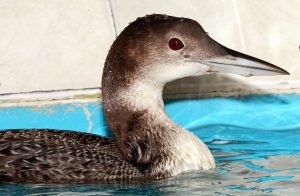Support Us
Since 1979 more than 140,000 animals have been treated by Wildlife Rescue.
Thanks to the support of individuals like you, Wildlife Rescue can provide a lifeline for animals in distress.
Found in lakes and ponds, Common Loons are a common sight from BC to New Brunswick. Known for their black bills and their black-and-white patterned bodies during summer, these birds have a different look from September to March when they have grey heads/backs and whitethroats.
With a large reliance on the water they inhabit, it is no surprise that Common Loons can easily be harmed by pesticides and other chemicals that end up in rivers and streams. This important connection to the wetlands they inhabit is why we need to be extremely careful about how we treat our environment.

With a diet that is mostly made up of fish, Common Loons require clear water to hunt sufficiently. Of course, they do have an alternative – when there are fewer fish and the water is murky, Common Loons will also eat snails, crustaceans, and leeches.
Food isn’t the only thing lakes provide loons – shelter is also found at lakes. When nesting, Common Loons will use hidden spots on banks close to the water for easy access to food and also because they can swim better than they walk. Made of marsh grasses, these nests are pretty hard to spot since they blend in with the grasses of wetlands so well!
Challenges They Face
Since Common Loons rely on wetlands so much any threats to wetlands are a threat to them. Because of this, negative impacts on wetlands can have unintended consequences for Common Loons. One simple example is the dumping of chemicals in rivers and streams – which often lead to wetlands.
Not only do the chemicals cause immediate damage to plant life and animals, but they have long-term effects that can cause great destruction as well. In fact, according to the United States Environmental Protection Agency’s reports, it can take years to clean chemicals from contaminated water.
Of course, even pesticides can harm wetlands! Since pesticides often get swept into lakes and rivers by rain, they then can kill snails, earthworms, frogs, and even fish, which are all vital pieces of the ecosystem.
Protect Waterfowl Species
Have no fear – there are many ways to help protect our wetlands! Simple actions and even large-scale petitions are all great ways to support the fight to keep our wetlands (and therefore our Common Loons) safe.
Of course, helping injured birds is a great way to help! If you see a bird that has exposed bone or blood, bugs or insects covering it, no feathers, or a bird that is sleeping, human intervention is required. Please contact our Support Centre for assistance.
Together we help keep our loons safe!